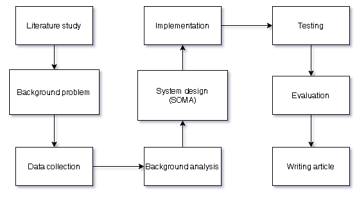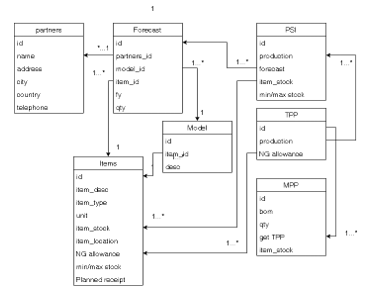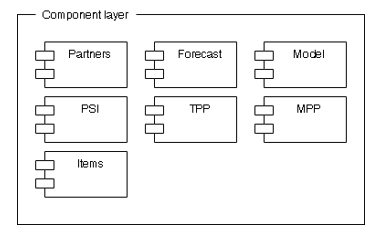Integration Information Systems Design of Material Planning in the Manufacturing Industry using Service Oriented Architecture
Volume 6, Issue 3, Page No 100-106, 2021
Author’s Name: Dimas Sirin Madefanny1,a), Suharjito2
View Affiliations
1Department of Computer Sciences, BINUS Graduate Program Master of Computer Sciences Bina Nusantara University, Jakarta, 11480, Indonesia
2Department of Computer Sciences, BINUS Online Learning Bina Nusantara University, Jakarta, 11480, Indonesia
a)Author to whom correspondence should be addressed. E-mail: dimas.madefanny@binus.ac.id
Adv. Sci. Technol. Eng. Syst. J. 6(3), 100-106 (2021); ![]() DOI: 10.25046/aj060311
DOI: 10.25046/aj060311
Keywords: Resource Planning, Production materials, Databases
Export Citations
PT XYZ has an Enterprise Resource Planning application that is used by the Planning Department to view stocks and plan production materials. Currently calculation of production materials takes more than 30 seconds just to export to Excel then a few minutes to adjust the data format to the planning form and the data used is not real-time. Each item needs to be calculated one by one per period, then the size of the Excel file used varies according to the time period and requires more storage. To support real-time integration and process efficiency planning and storage reduction, an integration between Enterprise Resource Planning application and web applications has been made using a Service Oriented Architecture approach. The Web service uses RESTful and has been tested using Quality of Service and the Vulnerability Test. Based on the test results using the Jmeter simulation with 10 users, it is obtained Latency 1.2 seconds and Load Time 1.2 seconds with an average amount of data sent 1280.73 bytes. The test results using OWASP ZAP show vulnerability to the web service header made from the web server version used by PHP version 5.6.40. With the results of these tests, the web service is able to replace the export and import process as well as create real-time data connectivity and replace storage media with databases, thereby reducing the time needed for planning activities.
Received: 08 January 2021, Accepted: 21 April 2021, Published Online: 12 May 2021
1. Introduction
A manufacturing company in Indonesia which is engaged in automotive industry, which has a Core Business in manufacturing car air conditioning components and other commodities in refrigeration spare parts for storage equipment. In a manufacturing company, accuracy and speed in planning and shipping finished goods are the benchmarks for the success of the automotive company business. In article [1], an ERP (Enterprise Resource Planning) information system designed to integrate all departments as a data center that becomes an information center for all parts of the company.
Based on article [2], using SOA approach on ERP will make would make the implementation on business process integration much better and easier. From the paper [3], the combination of ERP and SOA in software development will reducing the gap of support system and business processes.
Systems which not integrated and manual systems are weaknesses from implementation ERP system carried out by Manufacturing Company In material planning production at Manufacturing Company needs to perform processing Task using the Excel application prior to entry into the ERP system. In addition to processing data using Excel, you still need to export data from ERP by Copy-Paste Inventory into Excel format. The model has been proposed by [4], all personnel from various departments must work together for producing up-to-date and accurate reports. From the description, there are several problems that will be discussed in this research: (a) How to design a system that can increase the effectiveness of planning for production with SOA?; (b) How to design a service that can integrate several systems used in material planning?. The objective of the case study as follows: (a) To design a system that can improve the effectiveness of production material planning; (b) To design a system that can be used in Service-based material planning.
The benefits obtained from implementing a System Oriented Architecture in this case study are: (a) Increase efficiency and effectiveness in application development by reusing components / services [5]; (b) Bridging information systems with different platforms within the Manufacturing Company; (c) Provide flexibility to business opportunities; (d) Provide real-time information; (e) Improve application usage efficiency.
2. Literature Review
2.1. ERP Architecture
Article [6] proposed a modern ERP system architecture which has two physical architecture of ERP systems: Two-tier ERP architecture, Three-tier ERP architecture. There are many advantages in applying the three-tier architecture of ERP systems for the organizations over the traditional client-server architecture. For any type of ERP implementation strategy, whether it is to buy full out-of-the-box ERP products or to design and develop a custom ERP solution, the organization’s ERP project managers and specialists need to acquire a good knowledge of ERP software architecture.
2.2. Service Oriented Architecture RESTful
In article [7], the author proposed Service Oriented Architecture (SOA) for software integration, because it has become one of the reference patterns using a more concise SOA architecture based on the RESTful style for industrial process design and modeling. The objective of this research is to improve interoperability and flexibility in today’s manufacturing industry. In the evaluation phase, a simple Restful prototype and several industrial device scenarios were presented using two different methods: HTTP and Constrained Application Protocol (CoAP). From the research results, it is concluded that the performance of SOA architecture with the REST method in the manufacturing industry is able to answer today’s needs.
The application of IoT in article [8], the environments on different industrial require data services, processing, and big data integration for supporting the analysis platforms to strengthening unstructured big data storage capacity. The big data analysis will be processed through the relevant interface using the client and web server in HTTP transactions hosted by HTTP messages, and complete HTTP messages are usually plain text. The service is developed using the REST-based ASP.NET Web API on the Cloud server. Services that are able to provide reliable services for operational monitoring, asset management, and data visualization. Service separation occurs in the background between the front-end and back-end which increases the intelligence and accuracy of distribution management.
SOAP/WSDL has standard registry as described in research [9], where producer can register service specification and consumer can discover service endpoint using UDDI. Recently RESTful web service gained momentum in development of distributed application and research community already started discussion about RESTful based Service Oriented Architecture (SOA) but there is no standard central repository. The XML REST registry based services studied based on their dynamic nature as well as the quality of web-based services RESTful for complex scenarios such as travel scheduling..
The proprietary and widely used industrial project in [10], SOA methodology IBM RUP/SOMA supports the middle SOA analysis & design strategy, covering all SOA analysis & design activities. It also has the best prescription rates, as it provides a description of the activities, steps, inputs and outputs for each phase. It adopts existing techniques and notations such as BPM, UML, BPEL, WSDL, WS-BPEL
The benefits experienced in organizations of SOA implementation on article [11], can be divided into two subcategories: improved business agility and lowered costs. All twelve of the organizations in their researchexperienced improved business agility and lower costs as a result of SOA implementation.
The author proposed the security architecture on constructed adaptive way in article [12],. Enterprise application integration (EAI) is a well-known, industry-recognized architectural principle built on a loosely coupled application architecture. SOA web service has become the choice due to its simplicity in internet protocol. A new architectural paradigm appears in SOA, Representational State Transfer (REST) which has a security deficiency where it relies on network / transport layer security on Web 2.0 technology. In the research mentioned, the RESTful web service security vulnerability check was carried out using the OWASP rating methodology view and analysis of existing security solutions. Thus, the security architecture design is built in a way that is adaptive friendly Internet-of-Things (IoT) in an advanced way consisting of three cycle parts: learn, predict, and prevent.
The implementation Web Service on Laravel PHP framework in article [13], using RESTful API which become the mainstream after SOAP. This article explained how to effectively build a RESTful API. Micro services architecture become the standard of web services, and why RESTFUL API has become a major Web service development paradigm due to lightweight, scalability.
In article [14] explained the usage of the web services is expected to provide independency and fast integration. Article [15] presented the platform validates the incoming request from different consumers without any relation to the operating system or the programming language that the consumer uses. Since it uses http RESTful services then the approach will function correctly. As well, the provided framework requires the NodeJs to be installed and as known, the NodeJs is available for most used operating systems.
Advantages of a RESTful architecture described by [16], include a) communication advantages, such as reduced communication overhead and the possibility to introduce layers of caching, and b) system design advantages including stable service interfaces across applications and use of a resource-oriented information model in cyber-physical systems.
Implementation concept of ERP in Winmentor Enterprise using Extended Web RESTful services in [17]. The commercial documents for payment process were generated as PDF files by email to customers, linked with the central database via the REST services.
Integration application in large companies commonly using Service Oriented Architecture (SOA) related to article [18]. SOA-based solutions for enterprises have behaviors such as: loosely-couple, reusable, autonomy, composable, making SOA can be implemented in any business process entity flexibly, as long as the company has a business design. SOA provides better alignment between IT and Business processes, reduces IT burden, increases vendor diversity, and can support new technologies. Although IT adoption in SMEs and Large Enterprises is different, SMEs can also experience these benefits, with a good understanding of the characteristics of SMEs and a suitable SOA approach.
The SOA perspective in article [3], concludes that the question is not about SOA or ERP but rather to provide an ERP designed by SOA. By looking at ERP as a service, it is clear that the combination of ERP and SOA is one way forward when designing IS that aims to bridge the gap between IS and business, for example processes, and, enable businesses to fuse with IS to form a serviceable SOA-based ERP.
The communication problem that arose in [19], between ERP and automated transfer protocols was no standard, complicated configuration and this process was only done by experts. WETMAPS as an intermediary software, implements a web service called REST to provide solutions in data exchange between ERP and AGV systems. An ERP system sends information to an intermediary system and stores it in a database. For each robot sends status information to the AGV system, and is forwarded to an intermediate system then it is updated into the database to provide REST web services. The proposed system increases the work process functionality of the AGV system, without adding the latest versions and robots.
The integration methods proposed in [20], for Cloud ERP API and Internet of Things (IoT) basically in the form of SOAP or RESTful according to the semantic methods. The concept of integrating ERP services with IoT across the cloud can simplify mapping and enable new mappings and transformations when new services are created or API changes. From the proposed method, temperature data can be stored in the ERP database which can then be used as material for analysis or new action requests in ERP.
2.3. QOS Web Service
The rapid growth of web services become the key aspect for authors to demonstrates the functionality of web services invocation from distributed and heterogeneous environment [21]. The research not concentrated on issues like chance of service failure, response time etc. It is proposing a paradigm to create a new web service based on existing services called as Hybrid approach to enhance the performance of a web service.
The description on Quality of Service (QoS) on web service in article [22], are measured against functional metrics and non-functional metrics, namely the quality aspects of Web Service metrics. The Quality Attribute is what distinguishes Web Services. The International Tele Communication Union (ITU) defines Quality as “the totality of the characteristics of an entity that bears its ability to meet stated and implied needs” and technology giant Microsoft defines the Quality Attribute as “The factors that influence run-time behavior, system design, and user experience “
Table 1: Table Research Comparisons
| Method | Result |
| SOA, REST | A prototype of the lightweight RESTful Framework and several scenarios of industrial devices are presented and response times are measured using two different RESTful protocols: HTTP and CoAP. From the results obtained it can be concluded that the performance of SOA with REST in industrial environments is suitable for current needs. |
| REST | Web application developer Bay RESTful web API, which is potential in improving the Intelligence and Management precision of distribution grid |
| SOA, SOA analysis, SOA design, SOMA, SOAF | The most defining SOA methodology is the IBM RUP / SOMA which is a proprietary and widely used industrial project. It supports the middle SOA analysis & design strategy, covering all SOA analysis & design activities. |
| SOA | Benefits from SOA implementation can be divided into two subcategories: improved business agility and lowered costs |
| SOA, Web Services, REST | Examine the security vulnerabilities of RESTful web services in the view of popular OWASP rating methodologies and analyze the gaps in the existing security solutions, predicts the potential attacks on SOA based on obtained results by the developed theoretical security model, and the written algorithms as part of security solution prevent the SOA attacks. |
| SOA, RESTful | The Micro Service architecture is already the de facto industry standard for web services, and Restful Web Services has become the preferred technology model for Micro services applications due to its lightness, scalability, and HTTP protocol compatibility. |
The difference with the previous research and studies lies in the background of the case which point to the material being studied to extend the ERP for planning material. The conceptual architecture used for this research was RESTful web service because of the successful research conducted [17] could provide uniform interface, addressability, statelessness, and connectedness.
3. Methodology
The first step, search the literature about SOA then determine the background study and topic of research. Then do some analysis from the background problem and do some observation, data acquisition on the existing system that had been deployed. The next step was designing system architecture with the method selected for this topic research and do some testing afterwards based on quality of services had been created. The last step to evaluate and write the article based on the results.
3.1. Identification
This research was conducted against the background of the material planning process at Manufacturing Company which was not adopted on ERP implementation. The material planning process taken Place outside the ERP System using worksheets application. The data retrieval and calculation processes need several steps and applications used to produce production material planning.
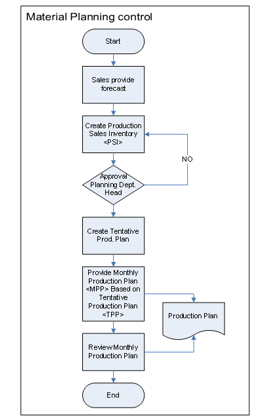 Figure 2: Flowchart material planning
Figure 2: Flowchart material planning
3.2. Data Collection
One of the methods in collecting data by the author is interviews and observations to related sections that have contributed to the making of material planning. After obtaining sufficient information, the problem is formulated in accordance with the current conditions (according to the time of observation). Then the SOA architecture literature review is carried out as a reference in providing solutions to the problems found and the SOMA (Service Oriented Modelling Architecture)[23] design method for the solution approach.
3.3. Current Condition
Figure 2 show the Business process from creating forecast and used by PPIC (Production Planning and Inventory Control) to create an MRP (Material Requirement Planning) document. Starting from Marketing which makes Sales Forecast which is used as the basis for making PSI (Production Sales and Inventory), then continues to make TPP (Tentative Production Plan) and MPP (Monthly Production Plan) before being approved as MRP (Material Requirement Planning).
3.4. Analysis
The analysis and system design are carried out in accordance with the reference literature used in the SOMA methodology. Then for this proposed design a descriptive justification is also carried out to test whether the proposed design has answered the problems that have been previously formulated. From the results of the descriptive justification conclusions and suggestions are drawn.
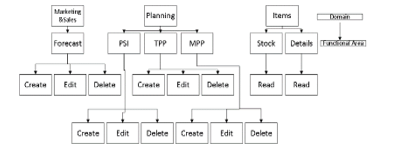 Figure 3: Decomposition Domain
Figure 3: Decomposition Domain
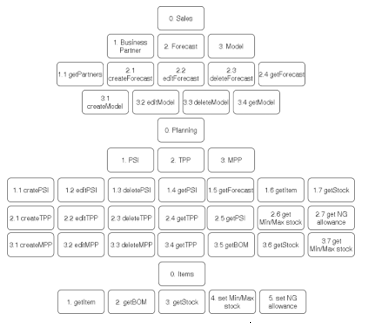 Figure 4: Service decomposition
Figure 4: Service decomposition
In Figure 3 shows the domain decomposition process from marketing, planning and warehouse, each domain has several processes. Sub process of marketing is making Forecast, create Forecast, delete Forecast, get Customer, get Project, get Order Quantity. Each business process will be decomposed in order to produce Service components.
Figure 4 showing the creation of Service Layers made of modules/function that being used as a service, the module Group are sales, planning and item and the PSI (Production Sales and Inventory), TPP (Tentative Production Plan), and MPP (Monthly Production Plan) act as a Service layer.
After identifying the service by defining the domain and function area, then developing in more detail into detailed services in Figure 3, the results are used as a service layer which will be used as SOA Solution.
At the Specification stage, a service component design is carried out which is obtained from the identification results in the previous process. The results of this stage include the services used to achieve the Goal Service Modeling and SOA architectural design. This stage is divided into 2 main stages, namely the Figure 5 Domain Model for mapping the content of object services and Component Specifications for mapping components in each of the main applications and the use of services by these components.
Figure 6, this stage is the final stage of the specification in which the services will be connected according to the component in more detail based on the specification stage that has been done previously
At this stage, Figure 6 is the final stage of the specification to define the components that will be used in connection with the service layer and business process layer to form a unified relationship starting from the Operational process layer, component layer, and also the service layer.
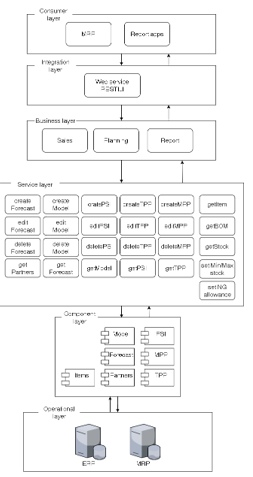 Figure 7: SOA Reference Architecture
Figure 7: SOA Reference Architecture
3.5. Implementation
From the detailed component results, generated the SOA Reference Architecture that will be implemented for integrating ERP application and MRP application using RESTful method built on web app framework MVC (Model View Controller)[24] Codeigniter which creating output in Json format and the Development using Visual Code.
Figure 7 was the process in creating the web Services accordance to SOA reference architecture.
4. Using the Template
For the evaluation phase in testing the web service, the Quality of Service reference is used and the tool used is Apache JMeter [25] and OWASP ZAP. Apache Jmeter serves to test web apps, but also designed to load test functional behavior and perform measurement while OWASP ZAP serves as an application vulnerability tool to find security flaws in web applications.
As measurement of web Services using JMeter[25] with a simulation of 50 user, and the measurement detail as follows:
Table 2: Throughput category[26]
| Throughput category | Throughput (Bps) | Indeks |
| Very Good | 100 | 4 |
| Good | 75 | 3 |
| Normal | 50 | 2 |
| Bad | <25 | 1 |
Table 2 throughput is the effective data transfer rate, measured in bps. Throughput is the total number of successful packet arrivals observed at the destination during the time interval, assessment formula Throughput = data received / delivery time.
Table 3: Latency category[26]
| Latency category | Delay (Ms) | Indeks |
| Very Good | <150ms | 4 |
| Good | 150ms – 300 ms | 3 |
| Normal | 300ms – 450 ms | 2 |
| Bad | <450ms | 1 |
Table 3 Latency is the time it takes for data to travel the distance from origin to destination. Delay can be affected by distance, physical media, congestion or long processing time.
The web service was tested using JMeter with a total quantity of process simulation of 50 users.
Table 4: Testing results using Jmeter
| Service | Latency | Throughput | Result |
| bom_get | 743.3 | 33.63348416 | Normal |
| details_get | 1150.94 | 51.38125 | Good |
| forecasts_get | 727.84 | 32.34844444 | Normal |
| forecasts_post | 857.08 | 21.2674938 | Bad |
| forecastsCountAll_get | 785.36 | 36.52837209 | Normal |
| inventory_put | 2537.46 | 85.43636364 | Very good |
| models_get | 794.74 | 35.7990991 | Normal |
| models_post | 879.08 | 27.73123028 | Normal |
| modelsCountAll_get | 803.3 | 37.89150943 | Normal |
| name_get | 839.68 | 37.82342342 | Normal |
| partners_get | 873.72 | 41.80478469 | Normal |
| partnersDesc_get | 669.3 | 26.45454545 | Normal |
| psi_get | 943.72 | 42.31928251 | Normal |
| stock_get | 775.86 | 34.79192825 | Normal |
From the test results Table 4, shows the number of sample data used as many as 50 processes, the throughput assessment results category may varies, relatively normal throughput depending on the amount of data pulled from the database. The best result get from the details_get service for pulling material item description only. The forecasts_post included in the insufficient category because getting all information for the first tme of the business process.
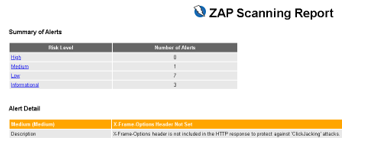 Figure 8: ZAP vulnerability test
Figure 8: ZAP vulnerability test
Figure 8 shows a web service testing project that has been created using OWASP ZAP, as a whole the web service shows that there are no bugs in the application but has a vulnerability in the Header-Rest Service which is in the RESTful server library.
5. Conclusion
The information system that has been created can be integrated with an ERP system that has a database platform and a programming language that is different from the SOA approach. Where the required business functions can be converted into services using the RESTful concept. With SOMA will help reducing the complexity of the architecture, these can be reused by other applications with different specifications.
Calling the services can be done easily because it uses the HTTP protocol, thereby increasing flexibility in the development of the next application that does not depend on the database and the same programming language.
Recommendation for the next development would be increase the performance and security of the services. Periodically evaluation needed to improve the system integration with deployment and development newer version of ERP.
- E.F. Monk, Ellen F.; Wagner, Bret J.; and Monk, “Concepts in Enterprise Resource Planning,” 493, 2001.
- N. Holmberg, B. Johansson, R.A. De Carvalho, “How to gain synchronization between business processes and enterprise resource planning systems: A SOA based perspective on ERP implementation,” in CONFENIS 2013 – 7th International Conference on Research and Practical Issues of Enterprise Information Systems, 2013.
- N. Holmberg, “A Service Oriented Perspective of Enterprise Resource Planning Systems,” Journal of Systems Integration, 8(2), 14–24, 2017, doi:10.20470/jsi.v8i2.304.
- H.F. Erdiyana, Suharjito, “ERP System Integration with Mobile Applications Using Service Oriented Architecture,” in Proceedings of 2019 International Conference on Information Management and Technology, ICIMTech 2019, 2019, doi:10.1109/ICIMTech.2019.8843745.
- Muhardany, Suharjito, A.A. Sukmadhani, E. Gunawan, “Development of E-commerce approach to service oriented architecture using SOMA methodology,” in Proceedings of 2020 International Conference on Information Management and Technology, ICIMTech 2020, 2020, doi:10.1109/ICIMTech50083.2020.9211161.
- M. Amini Valashani, A.M. Abukari, “ERP SYSTEMS ARCHITECTURE FOR THE MODERN AGE: A REVIEW OF THE STATE OF THE ART TECHNOLOGIES,” 2020, doi:10.22034/JAISIS.2020.103704.
- J. V. Espí-Beltrán, V. Gilart-Iglesias, D. Ruiz-Fernández, “Enabling distributed manufacturing resources through SOA: The REST approach,” Robotics and Computer-Integrated Manufacturing, 46, 156–165, 2017, doi:10.1016/j.rcim.2016.09.007.
- Y. Zhu, J. Li, J. Chen, H. Wei, “A framework research of power distribution equipment condition monitoring cloud platform based on RESTful web service,” in 2017 IEEE Conference on Energy Internet and Energy System Integration, EI2 2017 – Proceedings, Institute of Electrical and Electronics Engineers Inc.: 1–6, 2017, doi:10.1109/EI2.2017.8245318.
- D. Rathod, “Registry for RESTful Web Service: REST Registry,” International Journal of Research -GRANTHAALAYAH, 5(7), 128–135, 2017, doi:10.29121/granthaalayah.v5.i7.2017.2114.
- S. Svanidzaite, “A comparison of SOA methodologies analysis & design phases,” in CEUR Workshop Proceedings, 2012.
- T. Yoon, B.K. Jeong, “Service Oriented Architecture (SOA) Implementation: Success Factors and Realized Benefits,” International Journal of Information Systems in the Service Sector, 2018, doi:10.4018/IJISSS.2018040101.
- M.I. Beer, M.F. Hassan, “Adaptive security architecture for protecting RESTful web services in enterprise computing environment,” Service Oriented Computing and Applications, 2018, doi:10.1007/s11761-017-0221-1.
- X. Chen, Z. Ji, Y. Fan, Y. Zhan, “Restful API Architecture Based on Laravel Framework,” in Journal of Physics: Conference Series, 2017, doi:10.1088/1742-6596/910/1/012016.
- S. Widiyanto, A.B. Setyawan, A. Tarigan, H. Sussanto, “The developing one door licensing service system based on RESTful oriented services and MVC framework,” in AIP Conference Proceedings, American Institute of Physics Inc., 2016, doi:10.1063/1.4940297.
- M. Wael, Encapsulation of MES Functionalities as RESTful Web Services for Knowledge-Driven Manufacturing Systems, 2017.
- S. Grüner, J. Pfrommer, F. Palm, “RESTful Industrial Communication with OPC UA,” IEEE Transactions on Industrial Informatics, 2016, doi:10.1109/TII.2016.2530404.
- L. Rusu, E. Gerőcs-Szász, “EXTENDED ERP USING RESTFUL WEB SERVICES CASE STUDY: WINMENTOR ENTERPRISE ®,” JOURNAL OF INFORMATION SYSTEMS & OPERATIONS MANAGEMENT, 2018.
- P. Albertus Kusuma Seta, A.A. Arman, “General service oriented architecture (SOA) for Small Medium Enterprise (SME),” in 2014 International Conference on ICT For Smart Society (ICISS), IEEE: 217–221, 2014, doi:10.1109/ICTSS.2014.7013176.
- I. Draganov, S. Stefanova, “A solution for optimizing the integration of AGV systems in enterprises which are using ERP systems,” in HORA 2020 – 2nd International Congress on Human-Computer Interaction, Optimization and Robotic Applications, Proceedings, 2020, doi:10.1109/HORA49412.2020.9152869.
- D. Andročec, R. Picek, M. Mijač, “The ontologically based model for the integration of the IoT and Cloud ERP services,” in CLOSER 2018 – Proceedings of the 8th International Conference on Cloud Computing and Services Science, 2018, doi:10.5220/0006763104810488.
- R.R. Reddy, C. R. M., & Rao, “QOS of Web Service: Survey on Performance and Scalability,” Computer Science and Information Technology, 3(9), 65–73, 2013, doi:10.5121/csit.2013.3907.
- A. Negi, P. Kaur, “A Systematic Literature Review on QoS for SOA-based Web Services,” Article in INTERNATIONAL JOURNAL OF COMPUTER SCIENCES AND ENGINEERING, 2018, doi:10.26438/ijcse/v6i7.735444.
- A. Arsanjani, S. Ghosh, A. Allam, T. Abdollah, S. Ganapathy, K. Holley, “SOMA: A method for developing service-oriented solutions,” IBM Systems Journal, 2008, doi:10.1147/sj.473.0377.
- W. Warkim, D.I. Sensuse, “System Integration Model with Service Oriented Architecture Method Approach and Model View Controller at the Research Center for Science and Technology Development of the Indonesian Institute of Sciences,” Jurnal Teknik Informatika Dan Sistem Informasi, 3(1), 2017, doi:10.28932/jutisi.v3i1.572.
- S. Matam, J. Jain, JMeter Recipes, Apress, Berkeley, CA: 221–242, 2017, doi:10.1007/978-1-4842-2961-3_10.
- Y.A. Pranata, I. Fibriani, S.B. Utomo, “Analysis of Quality Of Service Performance Optimization In Data Communication Services Using Ns-2 At PT. PLN (Persero) Jember,” Sinergi, 20(2), 149, 2016, doi:10.22441/sinergi.2016.2.009.

